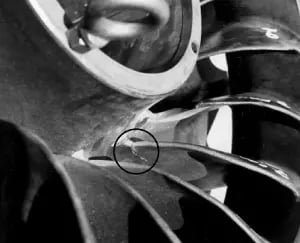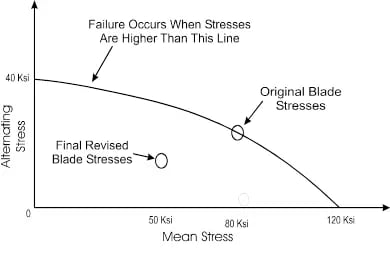Failure Analysis Of A Compressor Impeller
MSI was contracted by a customer to investigate a series of blade cracking problems in a compressor impeller. An FEA model of the impeller was created to perform a natural frequency modal analysis. The model was well correlated with experimental modal analysis vibration test results. Using strain gauges and transmitting the strain signals using a telemetry system.
The analysis confirmed that the failure was vibration induced fatigue caused by the synchronization between the vane/blade "sum and difference" three-lobe pressure-pulsation at blade-pass frequency and the natural frequency of the disc three nodal diameter mode. Based on the worst case loading situation occurring in service, the design was marginal, and the factor-of-safety was very close to 1.
Several “what if” possible modifications were tried in the FEA model, and the optimal recommendation suggested by MSI was able to increase the factor-of-safety by over 50%. The whole project was compressed into a very small time window due to the very tight overhaul schedule requirement. MSI was able to meet the customer’s needs by constructing and running the complicated model very quickly, using our powerful FEMAP and ANSYS Multi-Physics software. In addition, our unique capability to couple such analysis methods with advanced test techniques led to a solution that the customer could have confidence in.
REAL-WORLD EXAMPLES AND CASE STUDIES
MSI In Action
Case Study
Troubleshooting a Pipeline Renewable Diesel Screw Pump
Elevated vibration levels were causing a pipeline company screw pump problems.
Case Study
Petrochemical Ammonia Recip Compressor Piping Troubleshooting
Excessive motion by the discharge piping of a petrochemical ammonia reciprocating compressor startled the operators.
Case Study
Oil Tanker Pumping Station Screw Pump Troubleshooting
Troubleshooting a new oil tanker pumping station in Colombia consisting of 4 screw pumps. Specialized testing revealed that piping natural frequencies were to blame.



